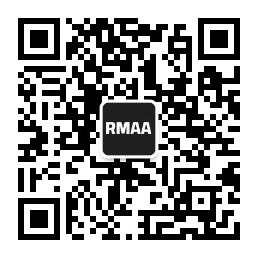Blog about successful marketing strategies in russia
Uzbekistan Out of Home Advertising. Market Overview


MEDIA BUYING
Share this Post
The outdoor advertising industry in Uzbekistan is actively developing. In 2024, LED screens accounted for 60% of the total budget, a 14% increase from the previous year. Advertising formats are also evolving, with the introduction of rooftop structures, transit ads, and 3D screens.
City streets are filled with ads, especially in categories like real estate, beverages, e-commerce, banking, and automotive.
|
|
|
|
|
|
|
|
|
|
|
|
|
|
|
|
|
|
|
|
|
|
|
|
|
|
|
|
|
|
|
|
|
|
|
|
|
|
|
|
|
|
|
|
Other categories are also well represented in the market but collectively account for just over half—52%. The remaining 48% is distributed among other segments.
Leading brands in outdoor advertising include local companies such as Uzum Market, Korzinka, and Uzum Tezkor. International brands are also among the top advertisers in Uzbekistan, though their market share is significantly smaller. Closing the ranking is the Yandex ecosystem, with its services and products like taxi and music.
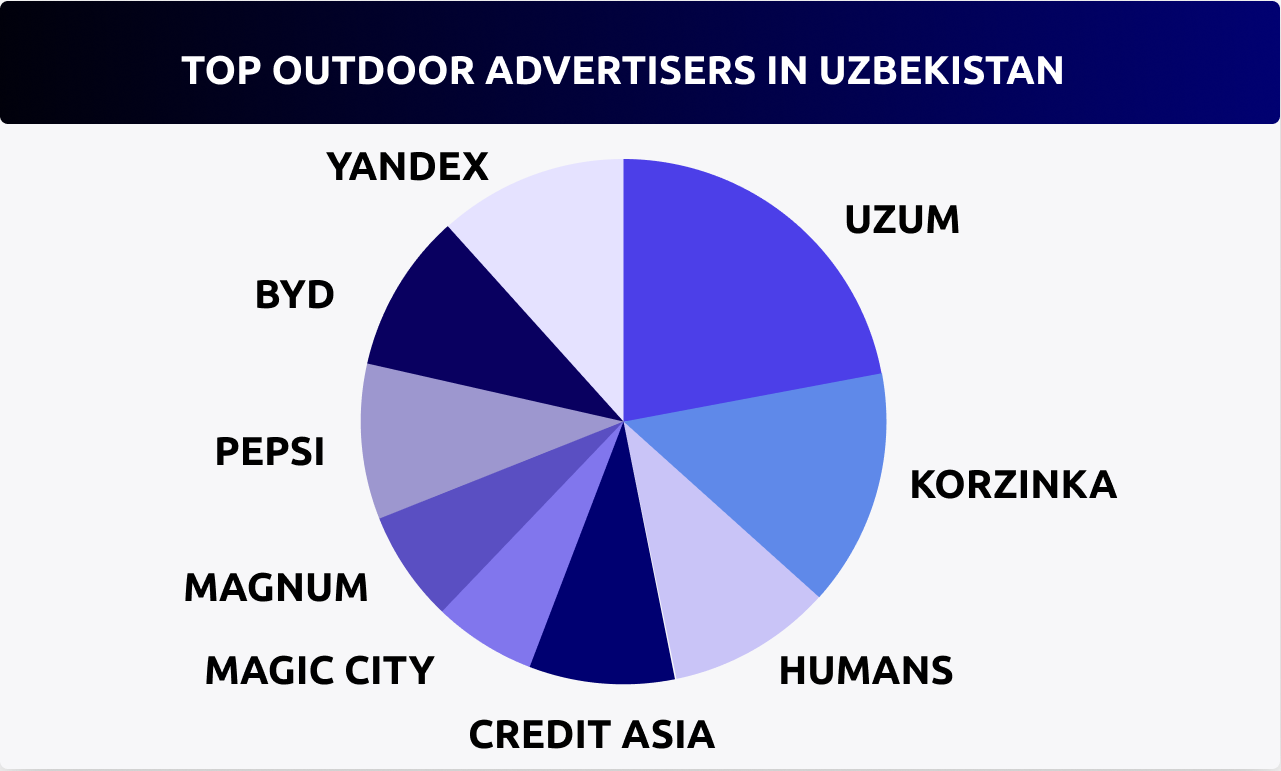
The highest concentration of digital screens is in the capital, Tashkent, where their number is twice as high as in all other regions combined—400 LED screens. The city also has a significant share of static structures, accounting for nearly a third of all installations nationwide. Meanwhile, regions lead in billboard placements, with over 3,500 installed, whereas Tashkent has significantly fewer—1,500.
Some cities already have enough advertising structures to achieve broad audience coverage. In Tashkent, this figure reaches 97%, followed by Samarkand at 86%, Namangan at 63%, Andijan at 54%, and Bukhara at 52%. However, in certain areas, outdoor advertising remains underutilized: Fergana and Karshi at 35%, Termez at 30%, Jizzakh at 24%, and Urgench at 19%.
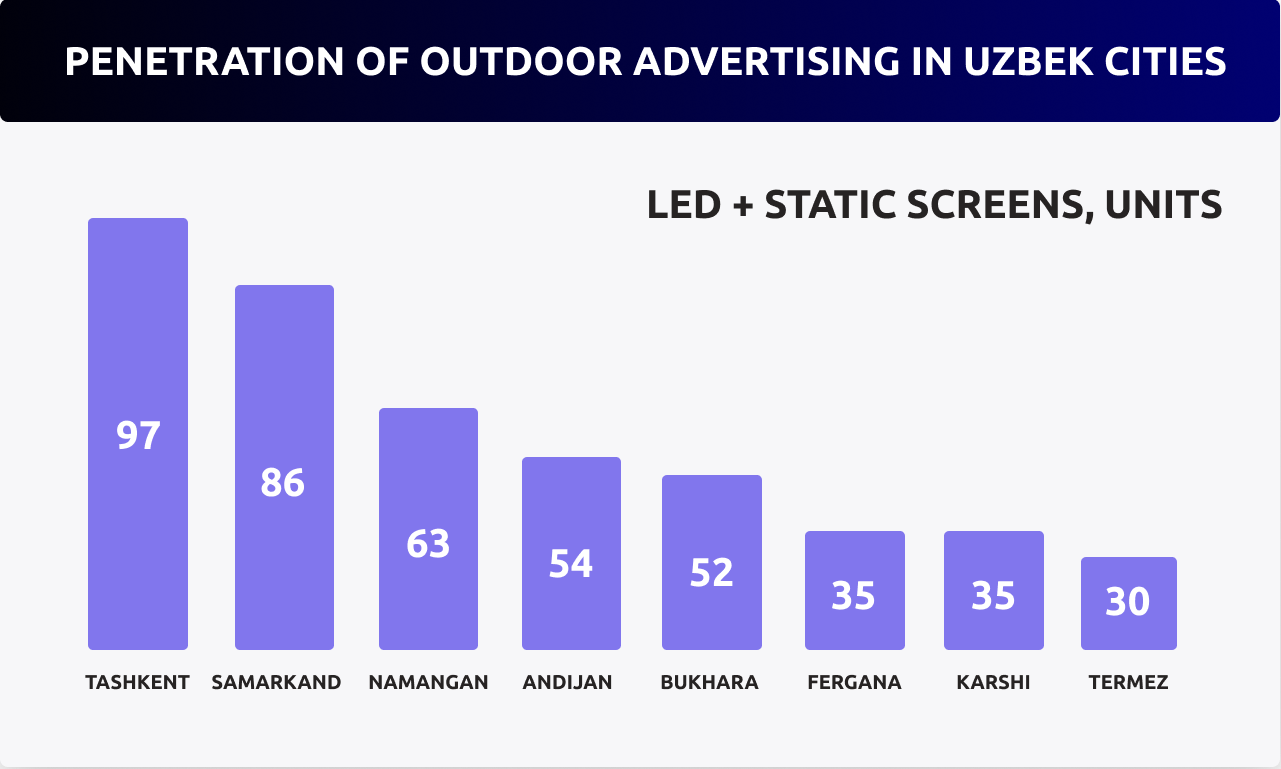
OOH Advertising Formats in Tashkent
Tashkent is now a dynamic metropolis where outdoor advertising penetration reaches 97%. Streets, squares, bridges, shopping centers, and transport hubs all serve as platforms for brands to connect with their target audience. Particular emphasis is placed on strategically important high-traffic locations, including major avenues and Tashkent International Airport.
Advertising at Tashkent Airport
Islam Karimov Tashkent International Airport is the largest aviation hub in Uzbekistan and one of the busiest in Central Asia. In 2024, it served 8.84 million passengers, a 30% increase compared to 2023.
The airport expanded its route network and welcomed nine new airlines: World2Fly and IberoJet from Spain, WizzAir from Hungary, Batik Air from Malaysia, LOT Polish Airlines from Poland, Qatar Airways, Ajet from Turkey, TezJet from Kyrgyzstan, and FlyAdeal from the UAE.
In 2024, the international terminal underwent reconstruction, increasing its area to 65,000 square meters, with upgrades to the facade, departure hall, and waiting areas. A dedicated drop-off zone was introduced at the entrance, along with the Pax Track system for monitoring passenger flow.
Further renovations began the same year, focusing on the expansion of the arrival hall and the extension of the facade. The arrival and departure zones are being integrated into a single complex with a capacity of up to 2,400 passengers per hour.
Every zone in the airport is strategically designed to maximize audience reach.
Let’s start with the CIP Departure Lounge, where passengers typically spend extended periods in a comfortable setting. This area features an LED screen that captures the attention of premium-class travelers. Advertisers targeting luxury services, travel, high-end real estate, or automobiles will find this an ideal placement, appealing to an audience accustomed to top-tier service.

LED screen in the CIP Departure Lounge
Now moving to the arrival area. Here, an LED screen is positioned to greet passengers immediately after they clear security and collect their luggage. This is a strategically important location, as arriving travelers are still under the influence of their journey and are more receptive to visual information.
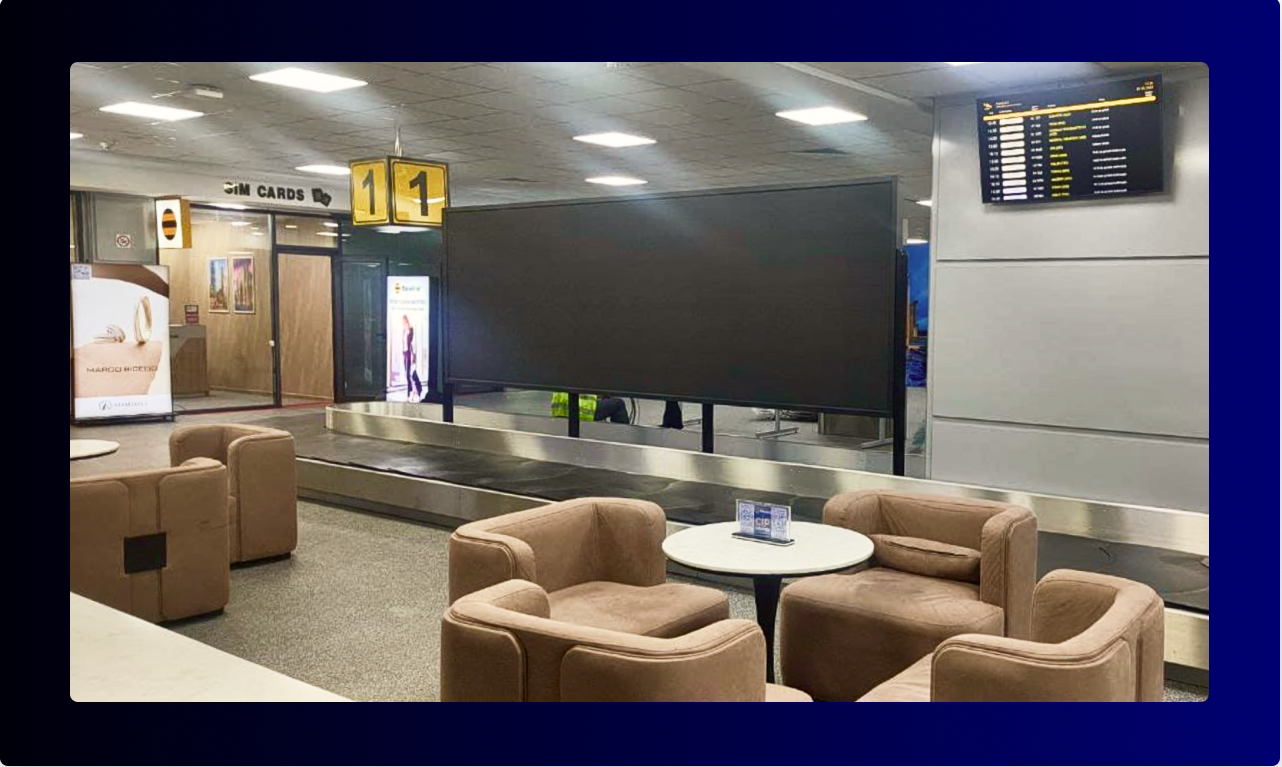
LED screen in the arrival area
This is an ideal spot for advertising hotels, transportation services, local attractions, or guided tours—everything that helps visitors quickly find what they need upon arrival.
Now, let's look at the Duty-Free area. Here, the LED screen is placed in a high-visibility location, ensuring exposure to all passengers browsing the shops. Travelers in this zone are often relaxed, in a shopping mindset, and more likely to notice something new and eye-catching. This screen is well-suited for promoting premium brands, duty-free store discounts, or unique local products that make great souvenirs.

LED screen in Duty Free area
Advertising in this area is also highly effective for promoting cosmetics, perfumes, and premium alcoholic beverages. The screens display dynamic visuals and vibrant videos that encourage impulse purchases, especially when showcasing exclusive or limited-edition items available only for a short time.
Next, let's look at the CIP Arrival Lounge. Here, the LED screen is positioned for an audience that values comfort and is accustomed to high standards. The content is tailored to promote investment opportunities, luxury real estate, educational services, premium automobiles, private medical centers, and high-end resorts.
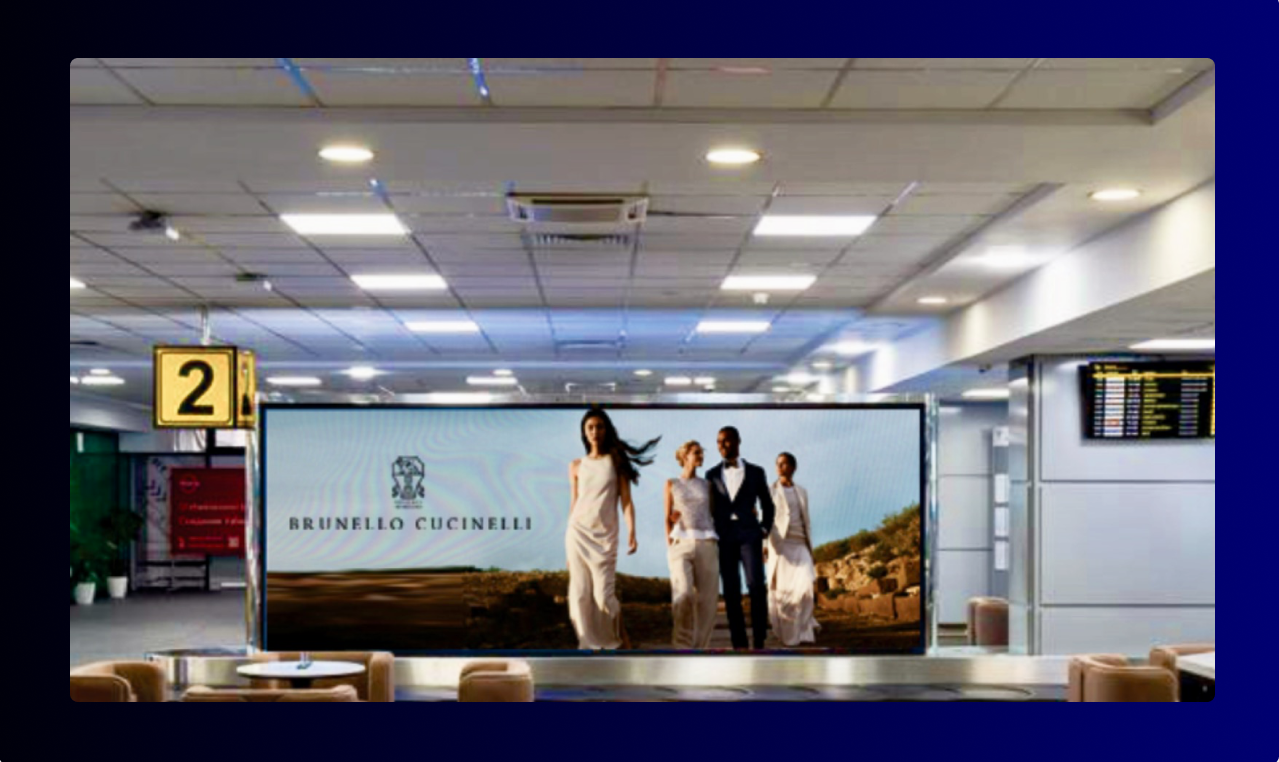
LED screen in the CIP Arrival Lounge
As for the departure area, the LED screen is positioned in a high-traffic location where passengers check-in or drop off their luggage. Since people inevitably spend a few minutes here, this spot is ideal for large-format advertising.
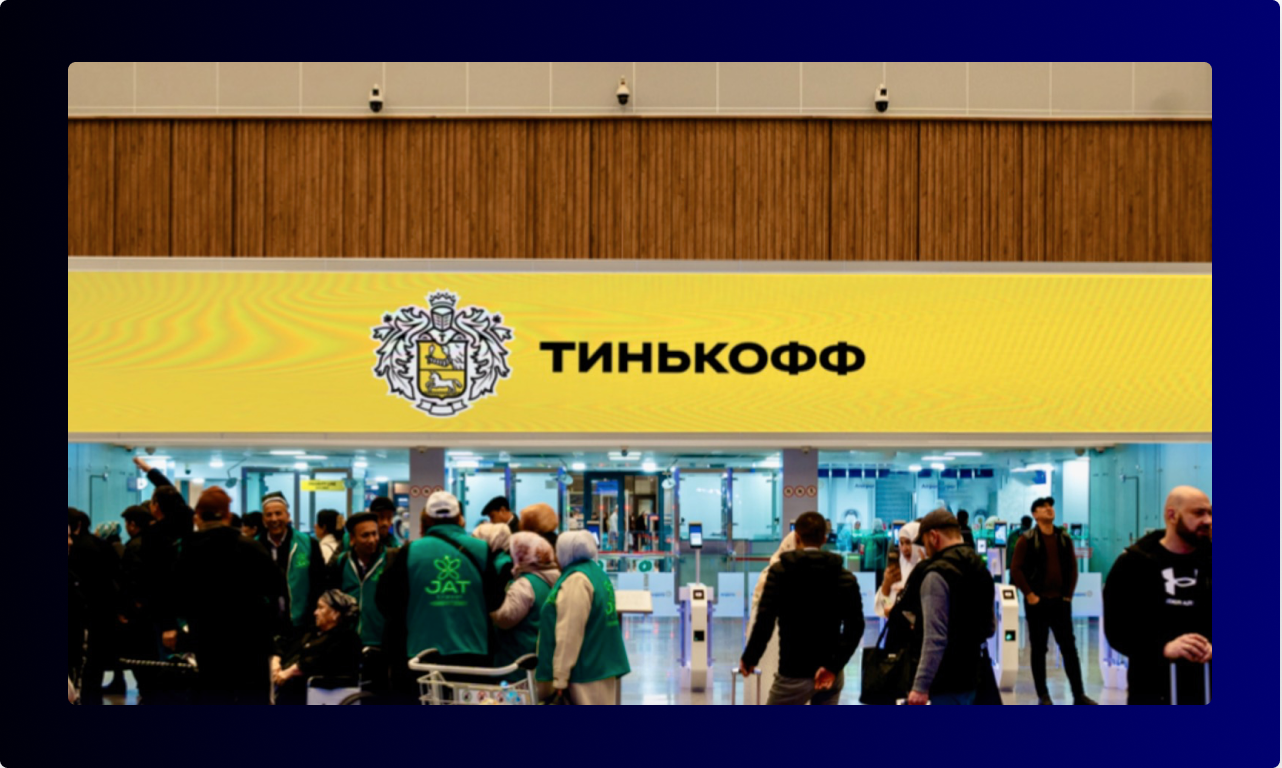
LED screen in the departure area
Advertising in this area is often geared toward universal services such as travel, mobile communications, insurance, and banking.
Monitors are also installed in departure and arrival halls, as well as in VIP and CIP lounges. Positioned in areas where passengers wait for their flights and spend free time, these screens are ideal for broadcasting tourism-related content, such as services available in the city.
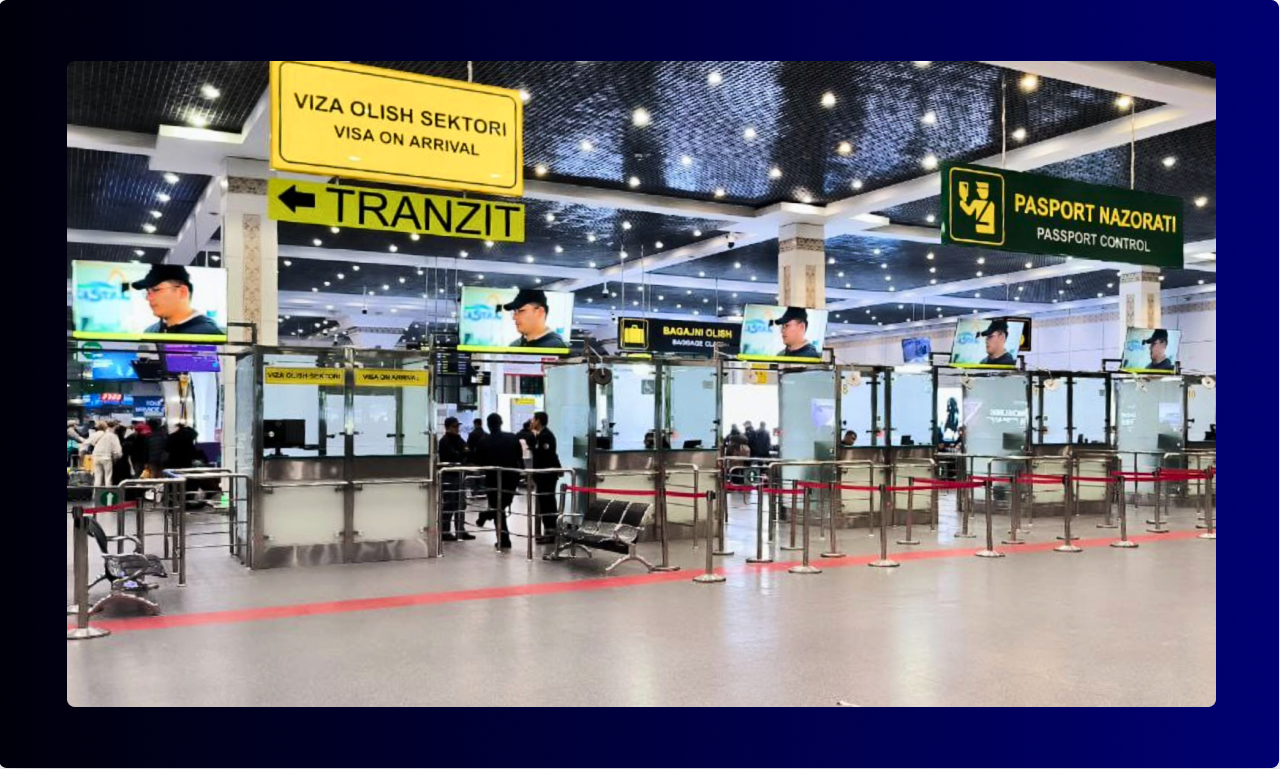
Screens in departure and arrival halls
Additionally, VIP and CIP lounges feature lightboxes. This type of advertising is static, but its bright illumination and sharp visuals effectively capture attention.
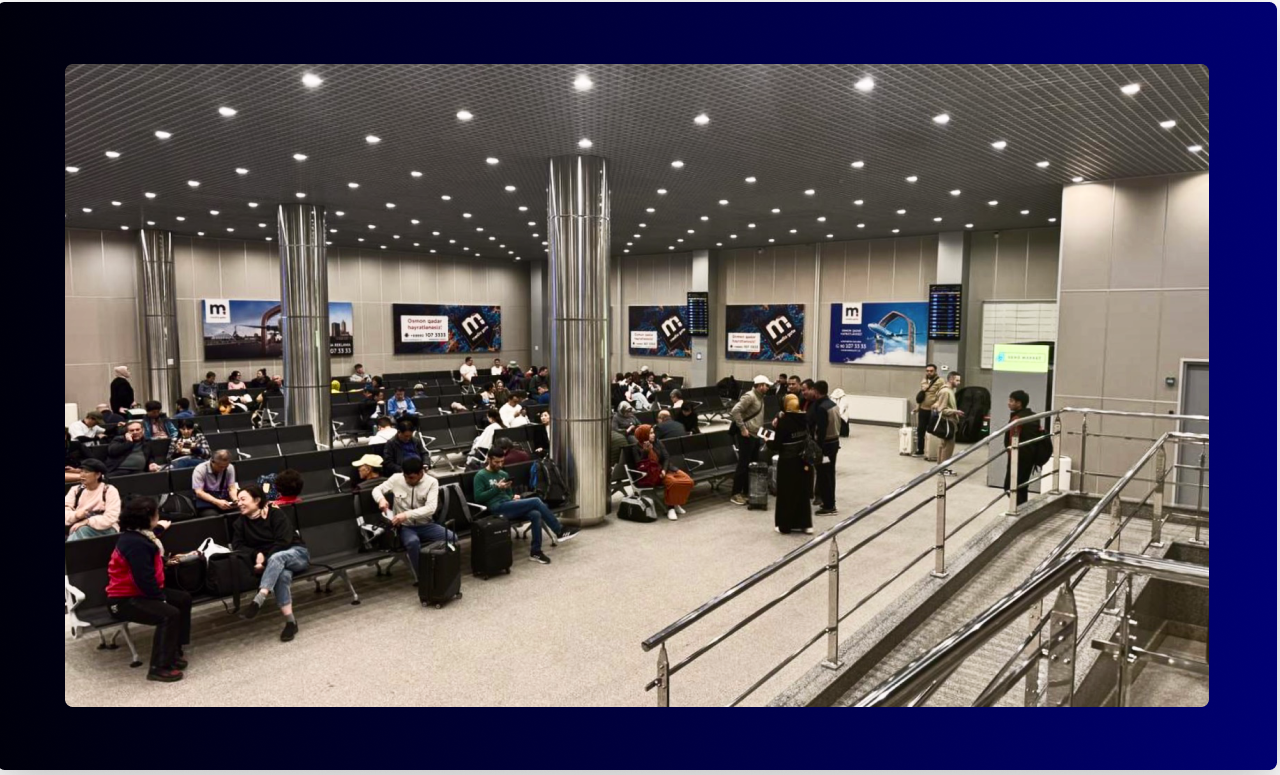
Lightbox in CIP lounge
Most Attractive OOH Locations
In 2024, Tashkent approved a new design code for outdoor advertising, created by the Digital Development Department under the city administration. The initiative aims to systematize the outdoor advertising market and create a more harmonious and safer urban environment.
In November 2024, district administrations in the capital began dismantling advertising structures that did not comply with the new design code. In seven districts, banners and billboards were removed. For instance, the Mirabad district administration reported the demolition of over 100 structures.
Currently, advertising structures in Tashkent can be found at key locations across the city.
One of the busiest spots is Samarkand Darvoza Street. A bright LED screen is installed on the facade of the Samarkand Darvoza shopping mall, attracting the attention of both pedestrians and passing traffic. This location was chosen for its high footfall and traffic flow. Every day, hundreds of thousands of people pass through this area on their way to work, shopping, or leisure.
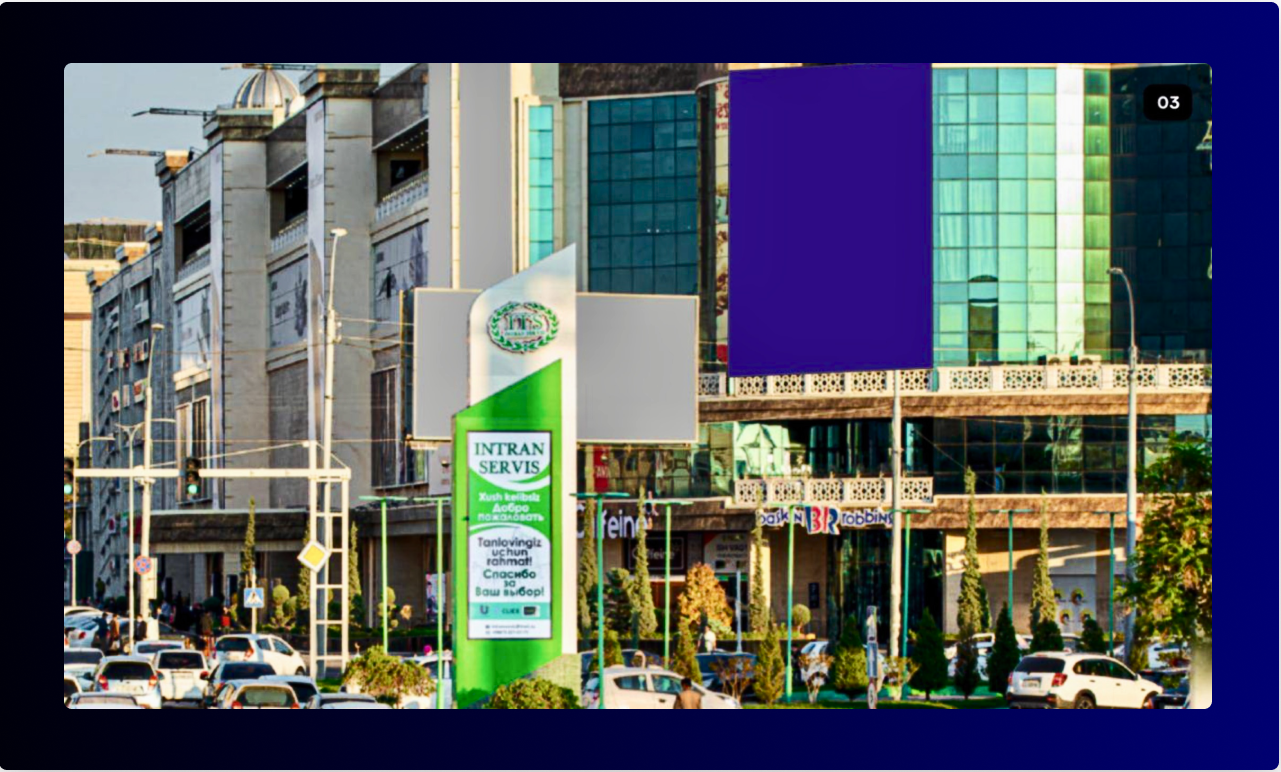
LED screen at Samarkand Darvoza Street on the facade of the Samarkand Darvoza shopping mall
This location primarily displays advertisements from major brands, along with promotions and events taking place inside the shopping mall.
Another fast-growing and bustling area in the city is the intersection of Mirabad Street and Sh. Rustaveli Street. It serves as a major transportation route and is home to key infrastructure, including shopping centers and the Grand Mir Hotel.

Visit Saudi DOOH Campaign in Uzbekistan, by RMAA 2024
Notably, the hotel accommodates not only tourists but also business professionals, as the area is a key business and cultural hub of the city.
At the T-shaped intersection on Temur Malik Street, a large complex of LED screens has been installed.
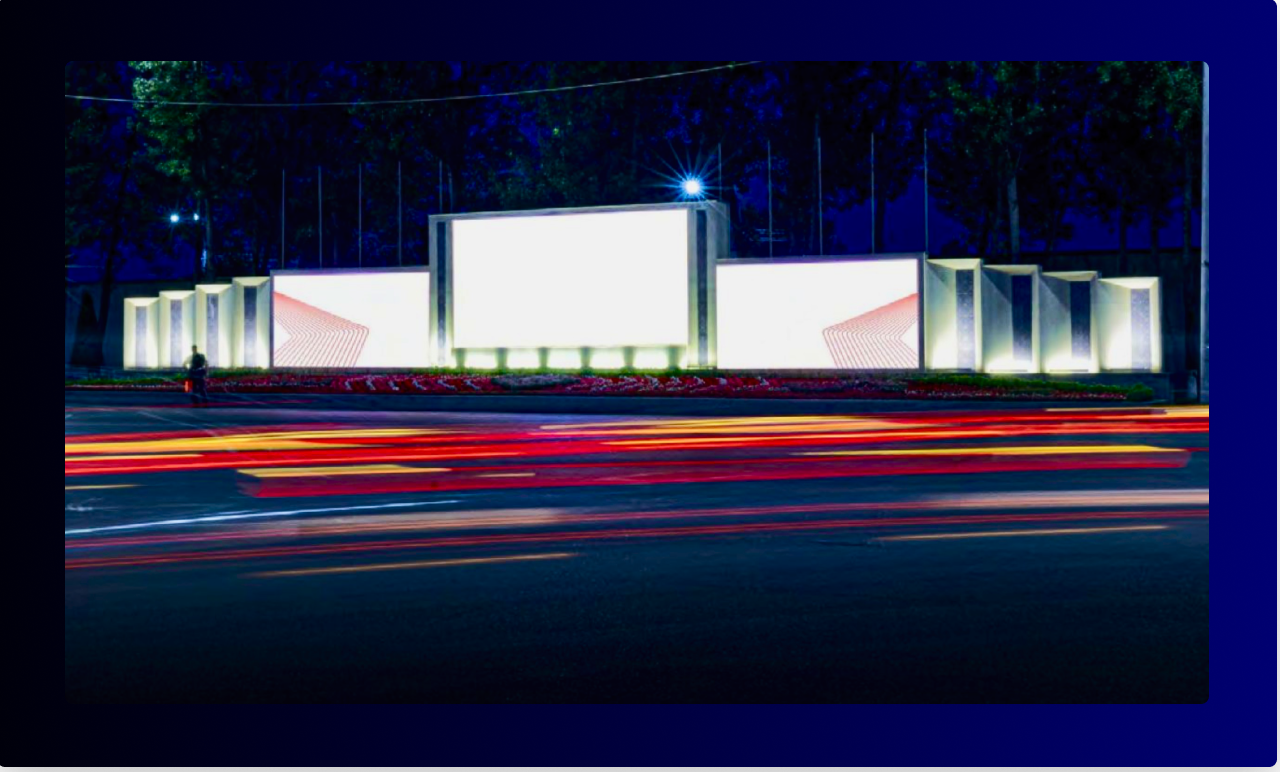
LED screens located at the T-shaped intersection on Temur Malik Street
The location was chosen strategically, as this road serves as a major transportation artery, connecting several key districts of the city.
At the roundabout where Akhangaran Highway meets the Tashkent Ring Road, a circular LED screen has been installed, immediately capturing the attention of drivers and passengers.
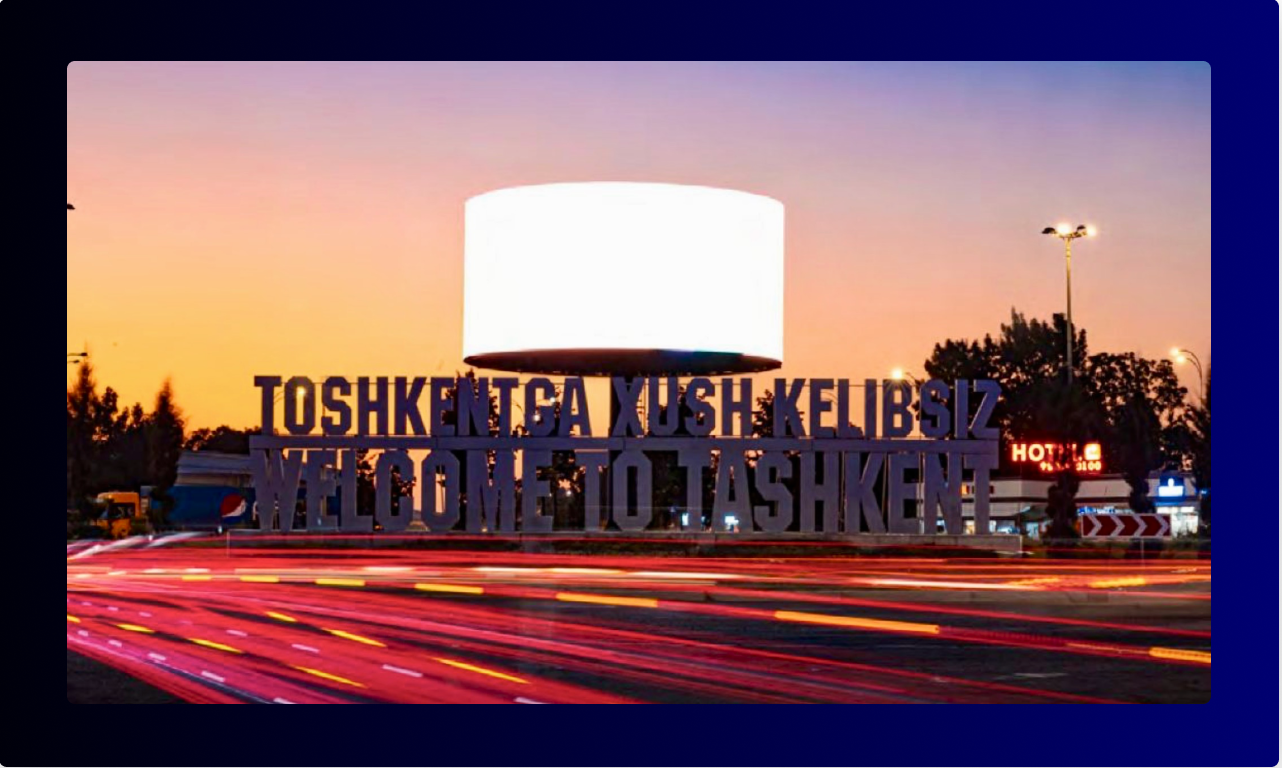
A circular LED screen at the roundabout of Akhangaran Highway and the Tashkent Ring Road
The roundabout at the intersection of Akhangaran Highway and the Tashkent Ring Road (TKAD) is a key transport hub, connecting different parts of the city while maintaining high traffic capacity. It is one of the busiest areas, where passenger and freight traffic converge, along with significant commuter flows from suburban areas.
At the junction of Akkurgan Street and Mustaqillik Avenue, a massive LED screen measuring 30 meters in length and 10 meters in height has been installed. This is one of the largest advertising displays in the capital. Visible from any point of the intersection, it effectively captures both pedestrian and vehicular traffic.
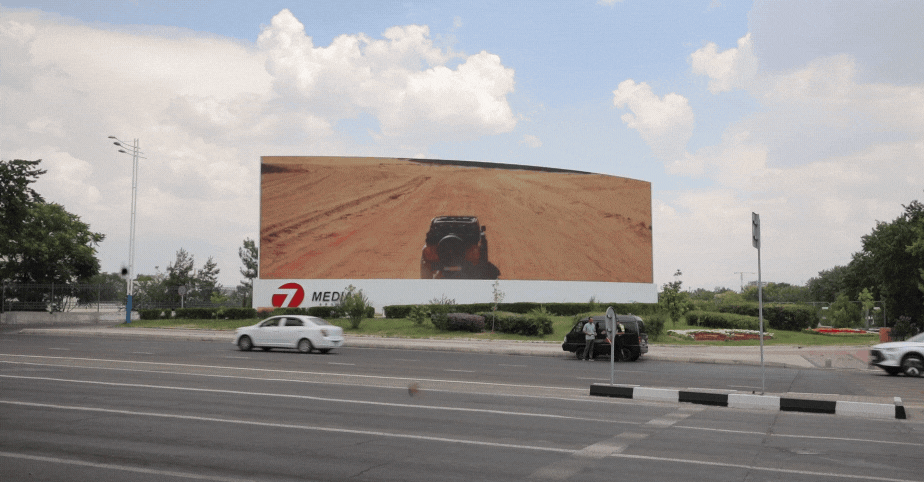
Visit Saudi DOOH Campaign in Uzbekistan, by RMAA 2024
Inside the parking area of Malika Market, a cube-shaped LED screen stands out, effectively drawing attention and serving as a powerful tool for displaying advertisements.

A cube-shaped LED screen inside the parking area of Malika Market (14)
Inside the parking area of Malika Market, a cube-shaped LED screen stands out, effectively drawing attention and serving as a powerful tool for displaying advertisements.
This parking zone is a popular spot for drivers, especially during peak hours. Malika Market is a major commercial hub, attracting shoppers daily. The cube-shaped design maximizes space utilization and ensures visibility from multiple angles. The screen is clearly seen by both pedestrians and drivers as they navigate the parking area.
Around 11 months ago, Tashkent saw the installation of its first Naked Eye 3D display on the facade of the newly opened Tashkent City Mall. This digital installation stands out with its ability to showcase immersive, volumetric visuals, creating a striking sense of depth and motion.
3D screen on the facade of Tashkent City Mall
Outdoor advertising in Samarkand
In Samarkand, just like in Tashkent, the outdoor advertising market is experiencing growth. Last year, its penetration reached 86%. Demand for advertising services began rising in early 2022, leading to an expansion of available ad spaces, including standard billboards and digital LED screens.
Additional statistics show that the "Outdoor Advertising" category in Samarkand's advertising agency directory received 23,255 views throughout 2024.
Samarkand Airport: Overview of Advertising Locations
Samarkand is home to an international airport that set a new record in 2024, serving 1.38 million passengers, a 37% increase compared to the previous year. This makes it one of the leading airports in Uzbekistan, second only to Tashkent. The most significant growth was in international flights, where passenger traffic rose by 43%.
This expansion is largely due to the airport’s growing route network. In 2024, Utair launched direct flights to Tyumen, Uzbekistan Airways introduced routes to Nizhny Novgorod and Irkutsk, the base carrier Air Samarkand began operating flights to Sharm El-Sheikh, and regional airline Silk Avia started flights to Fergana.
The airport offers excellent opportunities for long-duration brand exposure, with advertising placements ensuring visual contact with passengers for 30 minutes to 2 hours.
Starting with the main hall, this is a key area for outdoor advertising as it accommodates a significant portion of passenger traffic. Travelers spend time here waiting for their flights and completing check-in procedures, making it an ideal space for impactful ad placements.
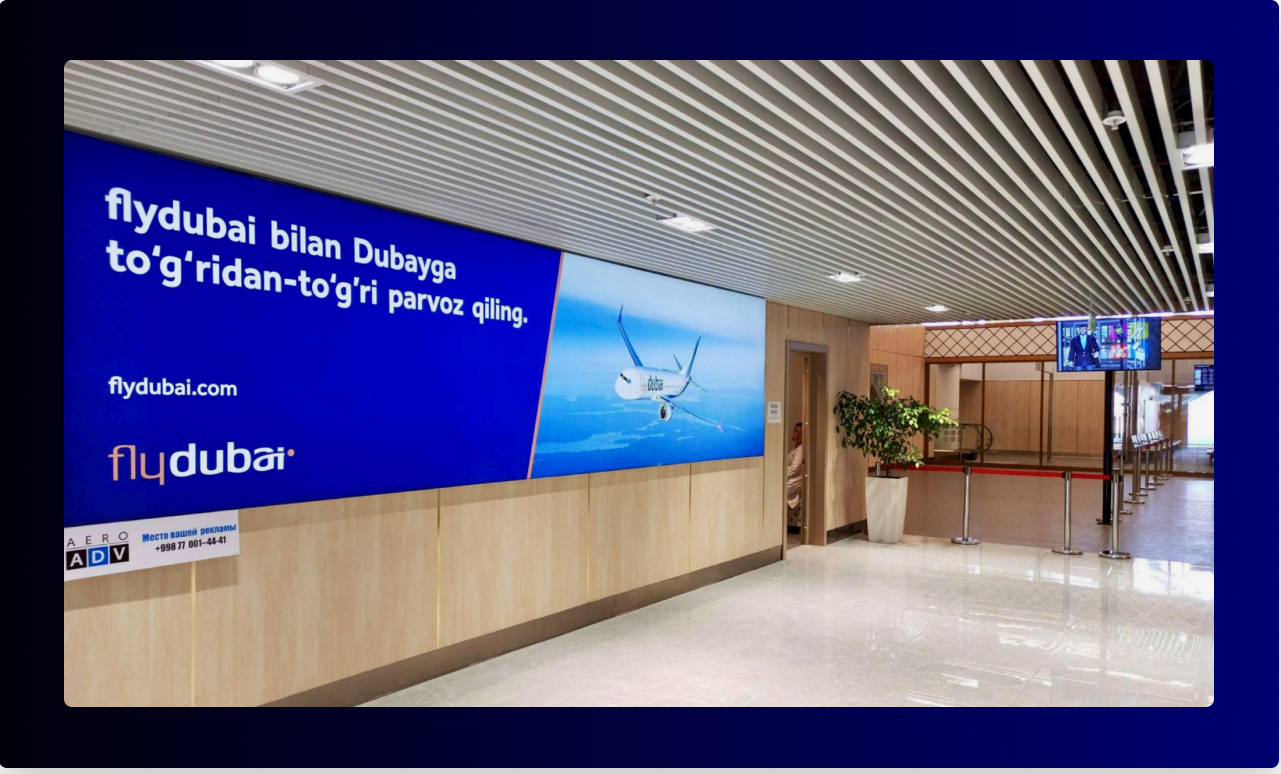
LED screen in the airport mail hall
Both static and dynamic advertising formats, such as LED screens, banners, and posters, which capture attention during waiting periods are particularly effective in this area.
The location is ideal for promoting travel-related products and services, tourism offers, and comfort-enhancing solutions for passengers. These include hotels, restaurants, duty-free shops, mobile apps for travelers, and even banking products.
Additionally, the main hall features another outdoor advertising channel—monitors installed near the check-in counters.
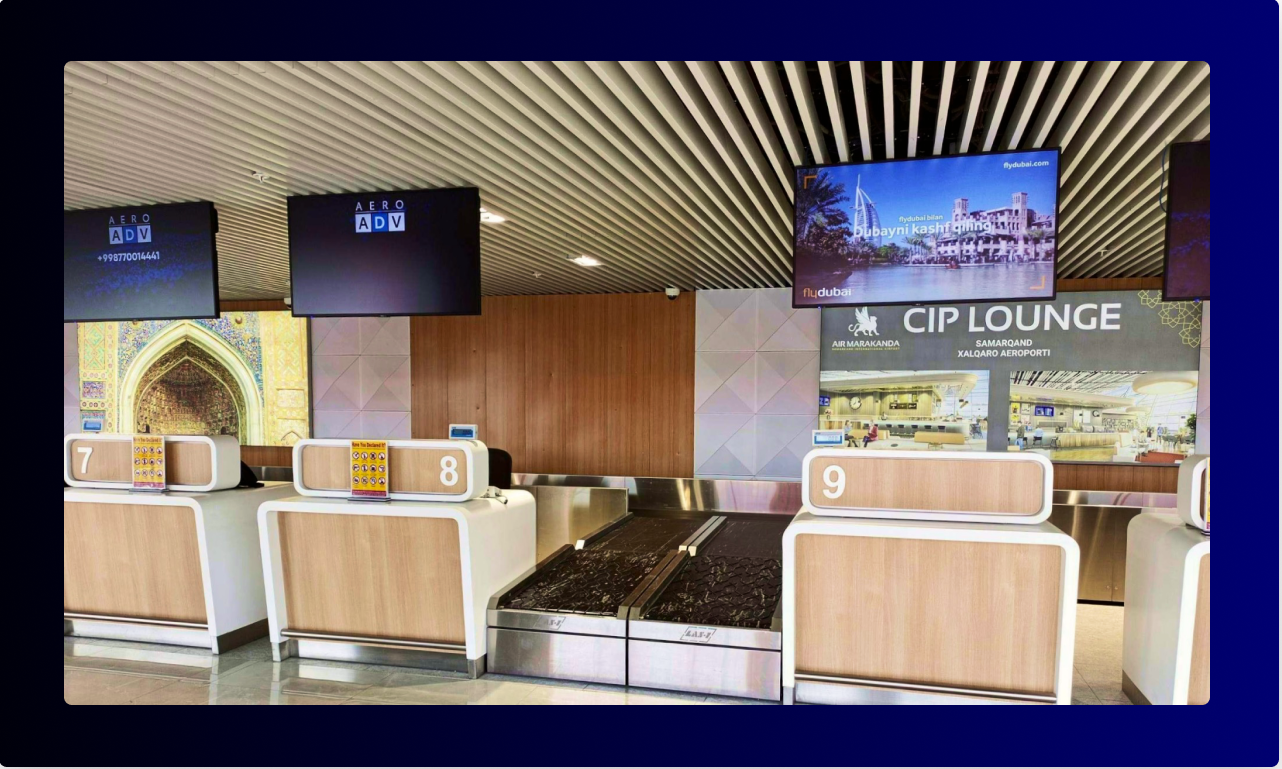
Monitors in the main hall behind the check-in counters
The effectiveness of this location is driven by its strategic placement. Passengers completing their check-in process naturally pay attention to the advertisements displayed. These screens are ideal for showcasing promotional offers.
The airport features arrival halls for both domestic and international flights, providing additional opportunities for various advertising installations.
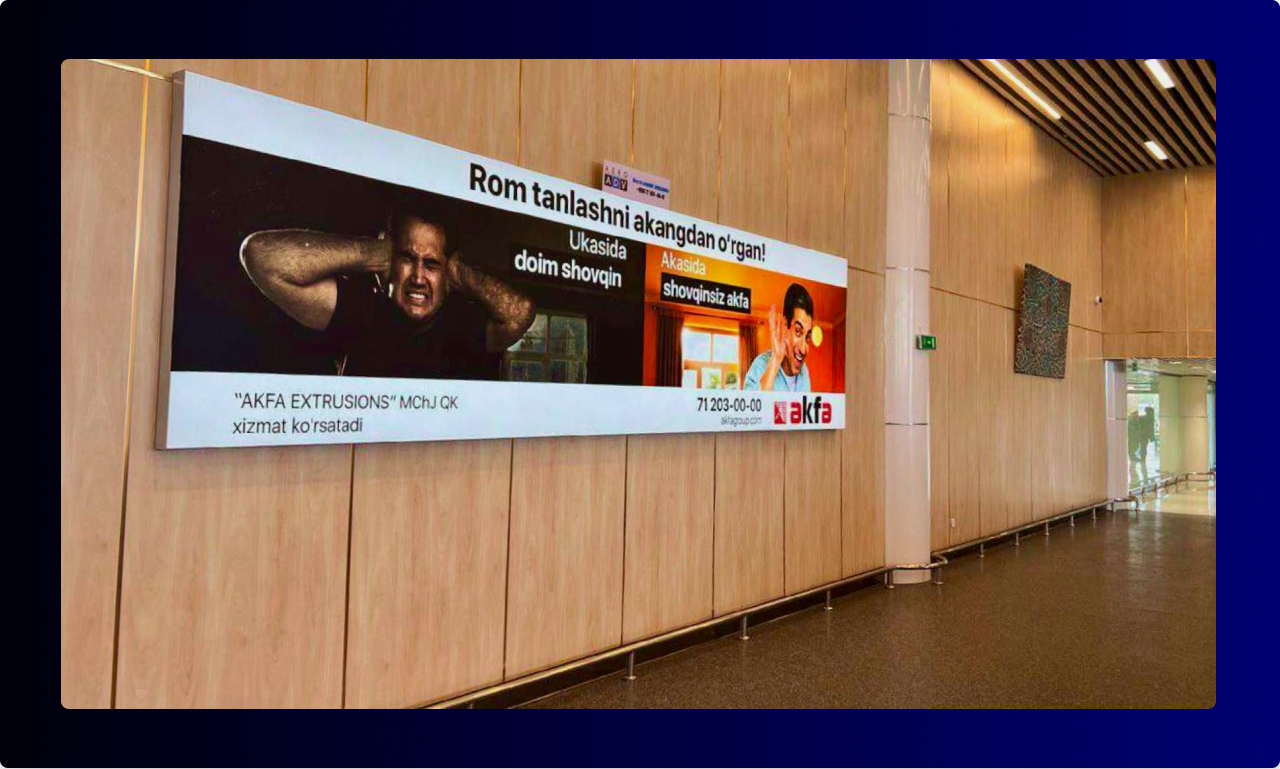
Billboard in the domestic arrivals hall
In addition, branded passenger boarding stairs and elevators can be seen throughout Samarkand Airport.

Branded jet bridge
Jet bridges and elevators hold strategically important positions, as all passengers pass through them. The first ones, for instance, are highly visible during boarding and disembarkation. Branded panels effectively capture attention at moments when people are in close proximity and are more likely to focus on visual content. This makes them an excellent placement for airline advertisements as well as brands offering travel-related products and services. Promotions for tourism services, travel apps, or special offers from hotels and restaurants are particularly well-suited for this format and are likely to resonate with passengers.
Available OOH Advertising Structures in Samarkand
The city primarily features billboards, which are placed on shopping centers and along major roads.

Advertisement placed on Atlas Shopping Center, Buyuk Ipak Yuli Street
Beyond the city streets, there is also an opportunity to advertise within the premises and on the facade of the Golden Samarkand Hotel, located on Gagarin Street.
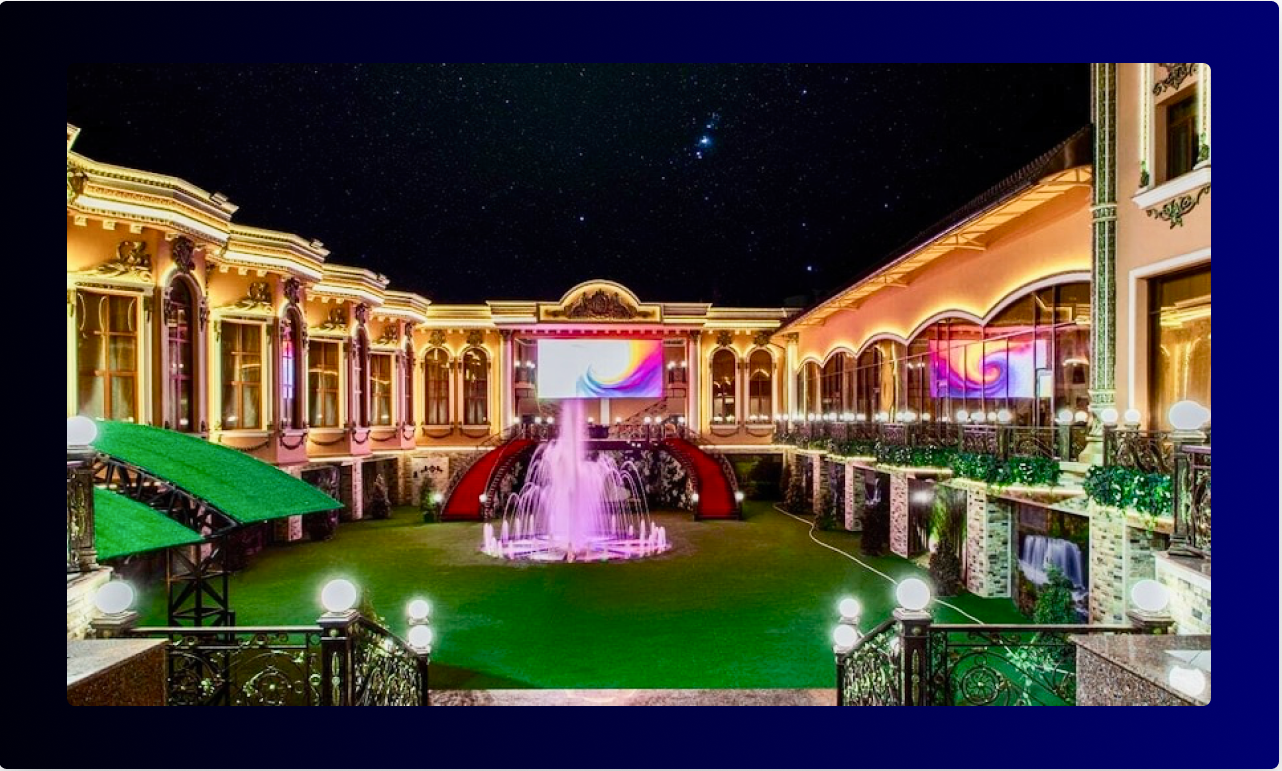
Monitors on the premises of Golden Samarkand Hotel
Situated on one of Samarkand’s central streets, Golden Samarkand is a prime location for outdoor advertising, being at the heart of the city's tourism and business activity. The hotel frequently accommodates both international tourists and business travelers, making it an attractive advertising spot.
The hotel's premises include both interior and exterior spaces that can be utilized for promotions. Large banners, posters, and LED screens can be placed on the building's facade, ensuring visibility not only for hotel guests but also for pedestrians and passing vehicles.
Other Cities in Uzbekistan: Bukhara, Namangan, Andijan – OOH Advertising Opportunities for Brands
In these cities, outdoor advertising penetration is lower than in the capital or Samarkand. Namangan stands at 63%, Andijan at 54%, and Bukhara at 52%. However, unlike smaller towns across the country, these cities hold significant economic, cultural, and historical importance.
Namangan, the second-largest city in Uzbekistan, is located in the northeast of the country, in the northern part of the Fergana Valley. Known for its agriculture and fresh fruit production, it serves as an essential agricultural hub. LED screens are commonly placed on shopping centers.
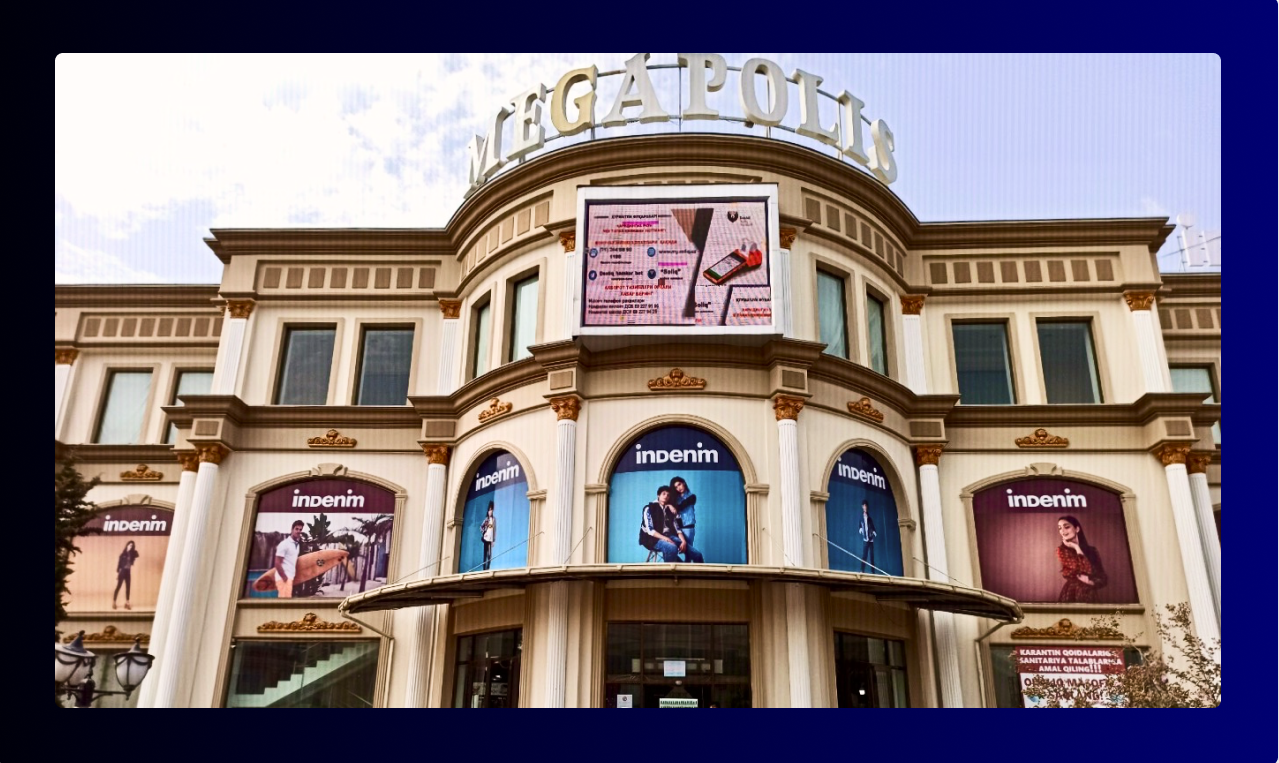
LED screen located on Megapolis Shopping Center, Namangan
Andijan is a key economic and cultural center of the region, recognized for its traditional craftsmanship, particularly in silk and carpet production. The city is also known for its historical monuments and deep-rooted cultural traditions.
LED screen installed on Navruz Shopping Mall, Andijan
Bukhara is one of Uzbekistan’s oldest cities, situated in the central part of the country. With a rich history, stunning architecture, and cultural heritage, it was a major center of trade, science, and culture along the Great Silk Road.
These cities attract significant tourist flows and have large populations. However, outdoor advertising development has been slower, possibly due to cultural considerations and strict placement regulations. In smaller provincial towns, OOH advertising is even less developed. Both its scale and formats are limited—billboards remain the primary option. The main reasons for this are the lower population density and limited investment in advertising infrastructure.
Outdoor Advertising in the Airports of Bukhara, Namangan, and Andijan
The international airports in these cities are less developed compared to Samarkand. Currently, Andijan Airport is fully closed for reconstruction. However, the other two airports experienced growth in passenger traffic and flight frequency last year.
Bukhara Airport
In 2024, Bukhara Airport served 551,864 passengers, marking a 14% increase, and handled 5,632 flights, up 4% from the previous year. Its current capacity is around 400 passengers per hour, equating to approximately 1 million passengers per year. It’s planned to build a new terminal, increasing capacity to 1,200 passengers per hour.
As of 2025, Bukhara Airport operates regular domestic flights to Tashkent, served by Uzbekistan Airways, as well as international flights to Moscow, St. Petersburg, and Istanbul.
As of January 2025, Namangan Airport handled 759,819 passengers, a 39% increase compared to the previous year. The number of flights reached 5,404, reflecting a 21% growth.
In addition to domestic flights to Tashkent, Samarkand, Urgench, and Bukhara, the airport offers direct international connections to Russia (Moscow, St. Petersburg, Samara, Irkutsk, Omsk, etc.), Turkey (Istanbul, Antalya), Saudi Arabia (Jeddah, Medina), Kuwait (Kuwait City).
Passenger traffic is expected to continue growing in 2025, with an expanding route network driven by increasing demand for air travel and ongoing airport infrastructure improvements.
In the international airports of Namangan and Bukhara, just like in Samarkand, various outdoor advertising formats are available in both domestic and international arrival and departure halls. Available options include lightboxes, LED screens, monitors in arrival and departure halls, branded jet bridges, escalators, and flights.
Let’s Summarize
The outdoor advertising segment in Uzbekistan, particularly in major cities like Tashkent, Samarkand, Bukhara, Namangan, and Andijan, continues to grow steadily. These cities, as key cultural, tourist, and economic hubs, offer advertisers prime locations with high footfall—on central streets, avenues, shopping centers, hotels, and airports.
The RMAA team will help you select the best advertising formats in Uzbekistan to effectively capture your audience’s attention. We work directly with leading outdoor advertising operators in Russia and the CIS, ensuring fast feedback, efficient location scouting, and favorable conditions for our clients.
To get in touch with an RMAA manager, please submit a request via the contact form.
Join 2,000+
of your Peers!
You will be the first to know about Russian marketing insights, news and updates from our agency. Stay tuned!
Get our latest articles delivered to your email inbox and get our exclusive White Paper
"A media buyer's quick guide for effective work in Russia"
for FREE!
How does the Media Buying Market in Russia Work?
Navigating the Media Buying System in Russia

Ready to partner with the specialists in Russian marketing and advertising?
About the Author
Expert in Media Buying. Julia specializes in optimizing and executing strategic media placements across Russia & the CIS region.
Join 2,000+ of your Peers!
Get our latest articles delivered to your email inbox and get our exclusive White Paper "A media buyer's quick guide for effective work in Russia?" for FREE!
You will be the first to know about Russian marketing insights,
news and updates from our agency.
Stay tuned!
We're updating our website's design step by step, so some pages may look different. Thank you for your understanding.
Got it








